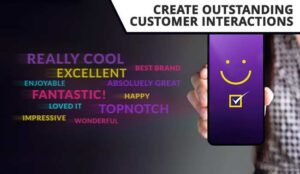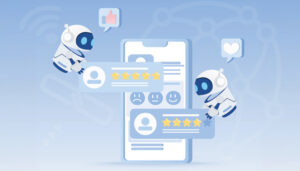Andy Traba at NICE takes a look at the role key strategies have in creating outstanding customer experience and provides some examples.
In today’s business environment, there are plenty of superior customer experience examples, but before we talk about the good, let’s analyze an example of what not to do to customers.
When my kids were smaller, there was an ice cream shop near our home that not only had the best flavors, but also a retro photobooth, a play area for the kids, and employees behind the counter who engaged even the shyest kids with smiles and jokes.
We enjoyed our visits so much, we established a routine of going every Saturday afternoon, and this went on for a whole summer.
We looked forward to our weekly visits, until the day came when I took my kids to get our weekly treat and the shop was in disarray.
The photobooth was gone, the play area was closed off for an unknown reason, and there was just one overworked employee behind the counter. We got ice cream that day, but we left and never went back.
You may think this was an extreme reaction, but I felt the business had really let me down. The atmosphere I had valued was no longer there.
This one bad interaction ruined the entire experience for me and I was no longer a loyal customer. That’s how fleeting customer loyalty can be.
Customer experience (CX) is the perception a customer has of a business based on a set of impressions.
These impressions can be anything from a TV commercial to a retail experience to a customer service experience, and more. Every time a person hears about or interacts with a brand can reinforce or shift his or her opinion.
In my case, my early perceptions were formed by that first extraordinary visit. But the final experience was enough to undo all the accumulated goodwill. The key takeaway? Brands need to be consistent with the CX they provide.
Highlighting the Role of Strategy in Shaping Customer Experience
Looking back at my poor customer experience example, it’s clear the business had a potentially winning CX strategy.
Considering its primary customer base—families with kids—outshining its competitors with a fun, enjoyable environment should have been a winning customer experience strategy.
However, the business could not execute consistently, putting them at risk for customer churn.
A successful customer experience strategy begins with a deep knowledge of the customer and what they need, expect, and prefer.
This level of understanding is derived from both structured and unstructured customer feedback and data.
Structured data typically comes from surveys and similar sources of customer feedback and can provide organizations with customer insights such as how satisfied people are with products or support, how much effort they had to expend during a recent interaction with the business, and whether they would recommend the brand to friends and family.
As helpful as structured data is, it doesn’t tell the whole story. For a more complete picture of customer experience, companies should also use customer input from sources such as product reviews, social media comments, and customer service interactions.
Because this can be a huge amount of unstructured customer information, organizations should use AI-powered tools, such as interaction analytics solutions, to analyze the data and transform it into actionable customer insights.
Another key input to a great customer experience strategy is customer journey mapping. A customer journey map enables businesses to walk in their customers’ shoes as they try to accomplish a specific goal, such as finding information, resetting a password, or making a purchase.
The best journey maps are visual representations of the different paths customers can take. They should include touchpoints, such as the corporate website and the contact centre, as well as key, CX-impacting information about each touchpoint.
For example, a contact centre touchpoint may include average speed to answer, first contact resolution rates, and customer satisfaction scores.
Ultimately, the purpose of a customer journey map is to expose sources of friction across the end-to-end customer journey, whether the friction is caused by individual touchpoints or the handoffs between them.
Addressing these rough spots will become part of the CX strategy. In my negative customer experience example, the business may have identified scheduling as a source of friction and made it a goal to improve their appointment scheduling processes and systems so that they could better honor appointment times.
Once developed, the customer experience strategy becomes the organization’s guide for delivering branded experiences and also helps prioritize CX initiatives and funding.
Analysis of Top Outstanding Customer Experience Examples
Let’s put that negative ice cream shop experience aside for now and instead look at some positive customer experience examples.
Since our Resource Center is full of case studies of clients that have achieved some impressive CX wins, we’ll focus on what three of them did to improve customer experience.
Regional U.S. Telecom Provider
The customer experience is often disrupted when a brand acquires another business that has its own way of doing things.
This was the case with a regional telecom provider, which was trying to integrate two recently acquired companies.
The expanding business was struggling with some issues, most notably high contact centre volume from customers with service or billing issues, and a frequent need for multiple visits from a technician to resolve on-site problems.
The business needed a better way to capture customer feedback so they could more effectively troubleshoot issues and identify root causes of contact centre volume.
They decided to implement CXone Feedback Management, an enterprise grade and scalable solution that collects and analyzes customer input. Based on customer survey results, this telecom provider identified the need to rework the repair experience. Having more customer insights also created momentum to become more customer focused.
The result? They were able to raise customer satisfaction by 30%.
This case study includes an element you’ll find in most positive customer experience examples—CX improvements based on customer insights. When businesses know and regularly listen to their customers, meaningful change is possible.
Producer of High-End Audio Products
Next up on this list of excellent customer experience examples is a brand that produces top quality audio products.
Shackled by complex, inflexible legacy contact centre systems, this consumer goods company knew it needed to modernize its technology in order to keep up with customer demands.
The old system was unable to provide real-time insights about voice of the customer (VoC) or agent performance.
And the reports it could produce were cobbled together from multiple sources and often too high level to act upon. The result was a very reactive approach to customer service.
Transforming their contact centre systems allowed this premium brand to regain control of every customer interaction and begin providing exceptional customer service.
The business was able to achieve a 34% year-over-year increase in customer satisfaction due to a number of factors, including:
- Improved intraday management. Using industry-leading workforce management (WFM) software gives the business the flexibility to quickly adjust agent schedules in reaction to higher-than-expected volume.
- Higher agent availability. Improved scheduling capabilities and real-time visibility to schedule adherence ultimately led to lower wait times for customers.
- Quicker issue identification. Because the company implemented a top-notch feedback management system, they can more quickly identify and address issues.
The key takeaway from this customer experience example? Technology can be either an enabler or a hindrance to achieving customer experience goals.
Businesses that want to improve CX should evaluate their current systems and replace them if they are not up for the task.
Global Electronics Manufacturer
Rounding out this list of great customer experience examples is a global electronics manufacturer that, like in the previous example, was struggling to make their legacy systems work for their needs.
Over the years, they had accumulated a patchwork of siloed solutions that were cumbersome for customer service teams to navigate and drove too many manual processes. This resulted in suboptimal agent and customer experiences.
To make matters worse, their BPOs (business process outsourcing) used their own systems, which meant the company had very limited visibility to their staffing levels or performance.
The business realized they could no longer run their operations on their antiquated systems and replaced them with modern, cloud-based contact centre solutions.
What a difference that made to both operational efficiency and the customer experience! With their new system, our client was able to consolidate all the applications their agents used into a unified desktop, which contributed to a 12% decrease in average handle time and 9% increase in first contact resolutions.
Greater transparency regarding BPO staffing led to a 20% reduction in vendor costs. And perhaps most importantly, their Net Promoter Score rose 20% and customer satisfaction received a boost of 9%.
Let’s look a couple of key takeaways from this impressive customer experience example. First off, employees need the right tools to deliver satisfying CX.
Streamlining the agent desktop allowed agents to focus on the customer instead of being distracted by outdated technology.
The second key takeaway is that what’s good for customers can also be good for operations. By updating their technology, our customer was able to enhance the customer experience while also reducing costs.
The Science of Measurement: How Customer Experience Impacts Business
In the previous section, we reviewed an example of how customer experience initiatives can help reduce costs by streamlining operations and providing better management data.
But perhaps the most powerful business outcome of mastering CX is the increase in revenue it can produce.
Brands that consistently provide exceptional customer experience often achieve an increase in customer loyalty, customer lifetime value, and customer acquisition.
Loyal customers tend to purchase more products and are less sensitive to price. All these factors contribute to significantly better financial results.
Boston Consulting Group reports that customer experience leaders experienced three-year revenue growth increases that were 190% higher than their peers.
Additionally, McKinsey & Company found that improving CX can increase shareholder returns by 7-10%.
Now let’s take a quick look at what companies can do to achieve similar CX-driven financial results.
Key Tactics That Make a Difference
Customer experience leaders typically leverage a set of best practices and proven tactics to set their CX apart from the competition.
Effective tactics are driven by consumer expectations and preferences, and can include the following:
Personalization
Customers value tailored interactions based on their history with a brand. This could mean providing relevant product recommendations, acknowledging their loyalty, or asking if they’re satisfied with a recent purchase when they contact customer service.
McKinsey research revealed that 71% of consumers expect personalized interactions and become frustrated when their expectations aren’t met.
Responsiveness
Responsiveness can mean anything from short customer service queue times to a retail associate effectively handling a complaint with empathy.
A good way to build brand loyalty is by showing customers that their time and business are valued.
Indifference is the enemy of positive customer experiences, while responsiveness is key to building customer trust.
Utilizing Technology
As our customer experience examples illustrated, technology is frequently an enabler of exceptional CX.
Modern technology nurtures customer loyalty through more effective support, personalized experiences, and backend analysis of customer preferences and needs.
On the other hand, when technology becomes a barrier to meeting customer expectations and running efficient operations, it should be replaced.
Continuous Feedback and Improvement
Because consumer preferences are constantly changing, businesses need to be poised to readily adapt to customer feedback.
This type of flexibility relies on having modern feedback management, reporting, and analytics tools to understand customer issues and expectations, as well as highly flexible operational software that can evolve with customer demands.
Employee Training and Development
If a customer service agent feels like they’re in a dead-end job, that will probably manifest itself in lackluster customer interactions.
Investing in employee training and development is critical for increasing employee engagement and creating a more customer-centric culture.
Take care of your agents and they’ll take care of your customers by delivering memorable customer experiences.
Challenges to Implementing Stellar Customer Experience
Customer experience initiatives can be complex to implement because they often impact groups across the enterprise and rely on data and functionality from multiple systems.
Here are just a few factors that can derail CX improvement efforts:
Data Silos
As we saw in our good customer experience examples, consistently providing positive customer experiences is a highly data-driven effort.
When customer data is in multiple, siloed systems, it’s difficult, if not impossible, to optimize personalization.
And when operational and financial data are trapped in multiple databases, it’s hard to measure the performance of new initiatives.
Additionally, data silos can prevent businesses from fully understanding customers, which can hinder the identification of CX-enhancing initiatives.
Organizational Silos
Improving customer experience can impact groups across the organization. Depending on the culture, this can mean project teams might encounter territorial roadblocks as they try to implement change.
A strong executive sponsor is a key to success for wide sweeping improvement efforts.
Apathetic Employees.
Whether it’s contact centre agents, website developers, or product managers, employee apathy will work its way into the customer experience.
Businesses should focus on employee engagement because engaged employees will go the extra mile to help their employer meet its business goals.
Cross-Channel Inconsistency
As businesses add more channels to meet customer demands, maintaining consistency throughout the customer journey becomes more difficult and complex.
A new mobile app or support channel can damage customer experience if they don’t meet the organization’s CX standards.
Outdated Technology
As we saw from our good customer experience examples, archaic legacy systems can be a barrier to providing exceptional customer experience.
As part of their development of a customer experience strategy, organizations should evaluate their systems to ensure they can support their CX vision.
Future Trends in Customer Experience
The future of customer experience will be infused with artificial intelligence. As forms of AI, such as large language models, become even smarter, you’ll see artificial intelligence leveraged throughout the customer journey to personalize interactions, resolve issues, and guide customers to reach their goals.
Behind the scenes, AI will make agents smarter and more effective and steer supervisors towards the most important areas to focus on.
We’ll also likely see a continued focus on personalization and omnichannel customer service, as there’s still plenty of room for improvement in both areas.
Proactive customer service, enabled by predictive analytics, will also continue to receive attention since it has the potential to be a differentiator.
To prepare for the future, businesses should focus on improving their agility and ability to adapt to unforeseen circumstances and shifting customer expectations.
This includes having modern technology that can help organizations turn on a dime. The future belongs to the nimble.
This blog post has been re-published by kind permission of NiCE-ltd – View the Original Article
For more information about NiCE-ltd - visit the NiCE-ltd Website
Call Centre Helper is not responsible for the content of these guest blog posts. The opinions expressed in this article are those of the author, and do not necessarily reflect those of Call Centre Helper.
Author: NiCE-ltd
Published On: 12th Dec 2023 - Last modified: 6th Sep 2024
Read more about - Guest Blogs, Andy Traba, NiCE






 NiCE (NASDAQ: NICE) is transforming the world with AI that puts people first. Our purpose-built AI-powered platforms automate engagements into proactive, safe, intelligent actions, empowering individuals and organizations to innovate and act, from interaction to resolution. Trusted by organizations throughout 150+ countries worldwide, NiCE’s platforms are widely adopted across industries connecting people, systems, and workflows to work smarter at scale, elevating performance across the organization, delivering proven measurable outcomes.
NiCE (NASDAQ: NICE) is transforming the world with AI that puts people first. Our purpose-built AI-powered platforms automate engagements into proactive, safe, intelligent actions, empowering individuals and organizations to innovate and act, from interaction to resolution. Trusted by organizations throughout 150+ countries worldwide, NiCE’s platforms are widely adopted across industries connecting people, systems, and workflows to work smarter at scale, elevating performance across the organization, delivering proven measurable outcomes. 









